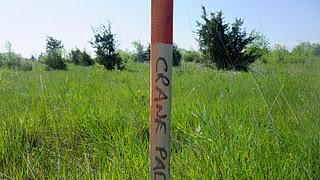One of rarest birds in Ontario lives at proposed turbine site
Prince Edward County Field Naturalists | Dec 29, 2011 | Comments 19
The Prince Edward County Field Naturalists share this blog from Nature Canada’s Manager of Bird Conservation Programs, Ted Cheskey, posted on Dec 22 http://naturecanadablog.blogspot.com/2011/12/endangered.html

Potential Henlow's Sparrow habitat at Ostrander Point could become site for 140-metre tall wind turbines. Photo: Ted Cheskey
By Ted Cheskey
Irony, or does the left hand not know what the right is doing?
The Endangered Henslow’s Sparrow (Ammodramus henslowii) is one of the rarest birds in Ontario. During the Atlas of Breeding Birds of Ontario 2001 to 2005, there were only 8 possible records of the species in the entire province.
For years, a breeding population of this tiny sparrow has persisted in upper New York State, not far from Prince Edward County, near the east end of Lake Ontario. The New York population could well be the “source” population for re-colonization of nearby areas like Prince Edward County.
Henslow’s Sparrow just happens to be one of a few Endangered Species identified by Stantec as a priority for their preconstruction surveying for Gilead Power Corporation.
Gilead is applying to build a wind energy plant with nine 140 metre tall turbines in the Ostrander Point Crown Land block in Prince Edward County, Ontario. In the Environmental Review Report of 2009, Stantec reported the following:
An assessment of the Study Area for potential Henslow’s Sparrow breeding habitat was completed. No optimal habitat was identified (Section 3.5.3 of Appendix C1). Three relatively small patches of marginal habitat for the Henslow’s Sparrow were the subject of playback surveys. No Henslow’s Sparrows were detected. The species has experienced significant decline in Ontario, and it should be considered absent from the Study Area.
On the surface, this seems like a reasonable conclusion right? I’m not so sure.
In 2010, Gilead applied for a permit to the Ontario Ministry of Natural Resources – the Ministry responsible for management of the Crown Land Block – to “kill, harm and harass Blanding’s Turtle and Whip-poor-will as well as damage and destroy habitat of Whip-poor-will” as part of their operational plan for the wind plant. As objectionable as this seems, I question why Henslow Sparrow was not on this list also.
Here is why.
In the conservation plan that William Wilson and I wrote for the Prince Edward County South Shore Important Bird Area, with the support of a strong local committee, including the local Ontario Ministry of Natural Resources District Ecologist, I learned that a restoration plan for the Henslow’s sparrow was written for Ostrander Point Crown Land Block that included brushing and prescribed burning in the late 1990s. It was never made clear if the plan was implemented or not at the time.
It was not until very recently, when reading through the Recovery Strategy for Henslow’s Sparrow from Environment Canada that I learned that Henslow’s Sparrows were present on Ostrander Point in 1999 and 2000 as a direct result of the implementation of this recovery action!
In the Recovery Strategy, this example was used to illustrate how restoration activities could lead to positive results. The MNR supported this restoration work on their land!
Something stinks about a process when we have a government agency, the Ontario Ministry of Natural Resources, invest in successfully restoring the habitat of an endangered species, then turn around a few years later and offer up its habitat for a small and unnecessary industrial wind plant.
Why is this process moving forward? Why has it gone this far? Why was it even conceived of in the first place?
The turbines are not built yet. Once they are, no longer will this be Henslow’s Sparrow habitat, or Whip-poor-will habitat, or Blanding’s Turtle habitat, but it will be a serious risk to all birds, including the river of hawks, owls and songbirds that stream through Ostrander Point every fall.
Over this Christmas period, my wish is that the Province or the developer recognizes that this is the wrong place to build a wind farm, and withdraws it before it goes any further. Wind energy should be about good ideas in good places, and this isn’t it.
MORE from the Prince Edward County Field Naturalists by clicking here
Filed Under: Uncategorized
About the Author: The Prince Edward County Field Naturalists, founded in 1997, is an affiliate of Ontario Nature. It provides an educational forum dedicated to the study, promotion, appreciation and conservation of the flora and fauna within Prince Edward County. The public is welcome at the meetings held on the last Tuesday of the month from September to May, except December, at Bloomfield Town Hall. Guest speakers introduce a variety of nature related topics. All members are encouraged to participate at meetings by sharing their experiences and observations. Regularly scheduled field trips in the vicinity offer members the opportunity to experience various habitats. Membership in PECFN is open to all. Contact: Prince Edward County Field Naturalists, P.O. Box 477, Bloomfield, Ontario K0K 1G0 Or Cheryl Anderson 613-471-1096

































So 14 years ago the area was cleared? Once? So why hasn’t Ostrander Point been managed so as to maintain the habitat for Henslow’s Sparrow? Why suddenly is this an issue again when no one did anything for the bird for that long? Why hasn’t PECFN been involved for the past decade?
Because the anti-winds have just dredged up another ‘reason’ why not.
or Environment Canada:from Amended Recovery Strategy for the Henslow’s Sparrow (Ammodramus henslowii) in Canada 2010
“In 1998 an adaptive habitat management project was initiated at Ostrander Point in Prince Edward County. Approximately on third of the area identified for treatment was mowed and cleared of brush. In 1999, bird surveys were conducted to determine if the mowing and clearing of brush had had a positive impact on Henslow’s Sparrow. Several singing males were heard in 1999 and again in 2000, indicating that with careful habitat mangaement, this species may again breed at this site (Environment Canada 2006)”
I wonder who to believe on this topic? Let’s see:
* Terry Sprague, with more than 45 years experience in nature studies and conservation in the County
and
* Ted Cheskey, Manager of Bird Conservation Programs at Nature Canada and previously an outdoor education specialist for 23 years
OR
* Donna _____
and
* John _____.
I think that I’ll go with the opinions of Terry and Ted.
I love how a bunch of people engaging in an argument where they have no background in a field of study are countering the argument of someone with 45 years of experience in that exact field.
The facts:
– the statement by the Prince Edward County Field Naturalists that Henslow’s Sparrows live at Ostrander Point is false;
– the habitat at Ostrander’s Point is not suitable for the Henslow’s Sparrow to breed;
– there is no evidence that Henslow’s Sparrows have successfully reproduced in Ontario in the last decade;
– the Ontario population of Henslow’s Sparrow in recent years is ‘barely above zero’.
Is this an issue in the debate about wind turbines at Ostrander Point? No.
John _ I am suggesting absolutely nothing and I haven’t the faintest idea how you would interpret that from my post. I was merely correcting some factual information on the Henslow’s Sparrow on habitat preferences and sighting dates that were given in another post. Nothing more. As a professional naturalist of more than 45 years, and having had experience with the Henslow’s sparrow on several occasions, I saw factual errors, and I corrected them. And by the way, 2012 minus 2001 (the date of the last sighting in our files) does not equal 16 years, as per your comments.
not sure who john is but I take exception to him contradicting Terry Sprague who has more knowlege about natualist issues than most people in PEC
Lori
From the ‘COSSARO Candidate Species at Risk Evaluation for Henslow’s Sparrow’ prepared May 2011 by MNR:
“In the recent past, in any given year, there are few (1 or 2 singing males) or no birds present on breeding territories in the province.”
“For all intents and purposes, the population of this species in Ontario in recent years has been barely above 0, and there has been no positive evidence of reproductive success.”
Terry, you are avoiding the natural history issues. Prince Edward County’s natural vegetation is forest cover. When Ostrander’s Point was cleared for lumber and farming, it provided a brief period of time when there was a meadow suitable for the Henslow’s Sparrow which is a grassland bird. It is not a species that is native to PEC; it was only here briefly because of the interference of man.
This is a very different situation than the Kirkland’s Warbler whose natural habitat was destroyed by man, and now needs man to maintain the habitat that existed before man.
What you are suggesting is that an enormous amount of ongoing resources be spent to create an artificial island of habitat for a bird that has not even been seen in 16 years, and may or may not choose to occupy it.
The issue is further complicated because the management practices of mowing or burning cannot be used at Ostrander’s Point because of the potential damage that it would inflict on the native, threatened species, the Blanding’s Turtle.
This means that every year the woody vegetation would need to be manually removed from the 100+ hectares that a breeding population requires; if that is not continued, Henslow’s Sparrows would quickly abandoned the site.
You, as a field naturalist, are certainly aware of this. There may be legitimate arguments with respect to wind turbines but the Henslow’s Sparrow is NOT one of those arguments.
Lori is absolutely correct with regard to peferred habitat and current status of the Henslow’s sparrow. The well documented sighting by both the Ontario Field Ornithologists and the MNR of two Henslow’s Sparrows in 1996 from June 11 to July 1 at Big Island seems to have been conviently overlooked, as have no fewer than 11 sightings, all in the Prince Edward Point area, from 1990 to 2001. Three of these involved sightings at Ostrander Road and Babylon Road in 2000 and 2001 and all are well documented in both my files and those of the Kingston Field Naturalists. “Extirpated” is a risky term to use given the difficulty in locating the species and given their current status at nearby Perch River, just across the lake, where numbers ranging from 50 to 122 were present as recently as 1999. One of the problems in locating the species is their preference to skulk about in the thatch and habit of singing only at night. Only experienced birders who are familiar with their unique hiccupping “song” are able to detect them. The Big Island birds, by the way, were present in an upland, very dry area of an uncut field of alfalfa, subsequently protected that year through the efforts of Mark Bailey, MNR conservation officer and MNR ecologist Todd Norris.
I was commenting on another false ‘fact’ put forth by the anti-winds. Can you explain it, Mark, rather than changing the subject?
(Perhaps ultra-Conservative mayor Rob Ford has something to do with Toronto’s problems.)
Obviously an “anti” environmental person. You may have the dollars to pay escalating energy rates for for an unreliable source, but many County folk do not. If this was a solution people might buy in but it is nothing but a poorly non thought out plan. I don’t want to see this beautiful County’s landscape marred with industrial monsters that harm our environment, our property values, tourism and our health. I still wonder why they are not stacking them up row upon row by the Toronto harbour. Hmmmmmm!
????!!!! “One of rarest birds in Ontario lives at proposed turbine site” ????!!!!
This statement is not true!!! According to the MNR and Bird Studies Canada, there has NOT been a breeding Henslow’s Sparrow in ALL OF ONTARIO since the early 1990’s.
In 1992 and 1993 only 1 Henslow’s was found in Ontario and that NOT in Prince Edward County; in 1994 NO Henslow’s were found in Ontario; by 2011 there was no evidence of breeding anywhere in ONTARIO. I was unable to find supporting evidence of the 1999 and 2000 ‘sightings’.
The restoration and sightings were not mentioned in a USGS 2003 report “Effects of Management Practices of Grassland Birds: Henslow’s Sparrow.” Other Ontario pre-1987 nestings were reported but NOT IN PRINCE EDWARD COUNTY.
Only 13 nests have been found in ALL OF ONTARIO…EVER!
And PECFN and the anti-winds are saying that the Henslow’s Sparrow LIVES at Ostrander Point???!!! This speaks volumes about the credibility of their ‘facts’.
John, I think you nay have missed a paragraph in the above article…
“Henslow’s Sparrows were present on Ostrander Point in 1999 and 2000 as a direct result of the implementation of this recovery action! ”
So it appears they did make a comeback.
“Local extinction, (aka extirpation), is the condition of a species which ceases to exist in the chosen geographic area of study, though it still exists elsewhere. Local extinctions may be followed by a replacement of the species taken from other locations.”
From the “COSSARO Candidate Species at Risk Evaluation for Henslow’s Sparrow” prepared May 2011 by MNR. In Ontario: “Since birds are present each year, it cannot be considered extirpated, even though their breeding status is uncertain”
http://www.mnr.gov.on.ca/stdprodconsume/groups/lr/@mnr/@species/documents/research/stdprod_091156.pdf
Secondly, the preferred habitat is not wetlands but they will tolerate and occupy wet habitats… “Henslow’s sparrows prefer habitats of high, dense vegetation and a thick layer of ground litter. Unmowed agricultural fields or ungrazed pastures are preferred for their thick cover.”
From US Wildlife & Fisheries: “There is clear documentation of massive loss of the species’ native prairie habitat … The Henslow’s sparrow needs tall and dense grasses and forbs with a well-developed litter layer for nesting habitat”
some references…
http://www.jstor.org/pss/4163383
http://www.museum.state.il.us/muslink/prairie/htmls/popups/birds_henslow.html
http://www.conservewildlifenj.org/species/fieldguide/view/Ammodramus%20henslowii
http://www.allaboutbirds.org/guide/Henslows_Sparrow/lifehistory/ac
The Henslow’s Sparrow is extirpated in Prince Edward County. I have read the report recommending the recovery effort but have never been able to find any evidence that it was undertaken.
Regardless, Henslow’s Sparrow has NOT returned to PEC. It has not returned because it requires wet, weedy meadows and wet, grassy fields; these are not naturally occurring in Prince Edward County. Ostrander Point is a perfect example of this. When the land was abandoned after agricultural use, wet meadows may have existed for a short period of time but natural succession soon made the habitat unsuitable.
The only way a Henslow’s Sparrow population might be sustained is through careful management by man to ensure wet, grassy fields and meadows. Were that work to be undertaken, it may be detrimental to the Blanding’s Turtle which IS present at Ostrander’s Point and is threatened. The building of wind turbines with their access roads will actual provide more nesting habitat for the Blanding’s Turtle.
So the argument with respect to the Henslow’s Sparrow comes down to: we don’t want wind turbines at Ostrander Point because it may impact a habitat that no longer exists for a bird that was probably never native to the area, and appeared only for a short period of time until NATURAL succession made the habitat unsuitable.
A more reasonable proposition would be to have the turbine company, which ALSO wants a grassy meadow, to include a suitable habitat for the Henslow’s Sparrow. Win/win with wind! 😉
I don’t believe the government cares. And I don’t believe the folks pushing this industrial wind farm care either. To go down this irresponsible path with no care for the environment or human health and to disguise it as being green is sad. Energy costs rising near 50% in 4 years for an unreliable monster. It is all about $$$$, and the ones paying are the province which is in financial crisis and the consumer that is finding it increasingly hard to make ends meet. And the Green Energy Act gives us NO say! Just shut up, we know what is best for your County and we will do what we want. Get over it! It is truly a sad state of affairs. The County folk need to stand up. It is truly worth fighting for, for our own rights and those of future generations.
I believe “The County” as a whole, Must Stand Up to the current Liberal Ontario Government, ask for the justification!!on this KILLER Project in a Protected Zone and also to please justify the ridicules Hydro Increases forecasted during the next 5 years due to the “FIT” incentives—- to make Dalton “Look Good In Green” and it’s ripoff priceing formula to a selected few!!
Unfortunately, Industrial WInd Turbines are not really about creating green energy, but creating more green for investors. The Green Energy Act (GEA, aka Greedy Energy Act) removed our democratic power to decide for ourselves what is right for our community. There is a place for wind generated power, but not at the expense of the environment, to harasses, harm and kill or maim endangered or threatened species. The cost of these behemoths will bankrupt our children and grandchildren and this province is already facing a debt crisis. With the loss of so much manufacturing to China and other Asian nations we enjoy a surplus of energy.
We need not rush to build these IWTs, we have the time to do the health and noise studies have never been done. (That’s why all the “peer reviewed” studies conclude there is no evidence of danger to health since there are no such studies to review)
These studies must be done before any such project as The Ostrander Point Wind Farm is built and any part of the south shore of Quinte Isle is destroyed.
I couldn’t agree more!!